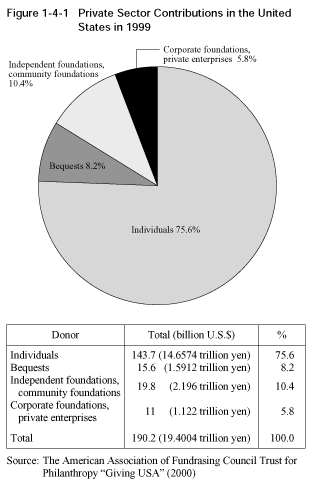| Home > Policy > White Paper, Notice, Announcement > White Paper > Japanese Government Policies in Education, Science, Sports and Culture 2000 > Part 1 Chapter 4 Section 2 2 | ||
In 1965, the National Endowment for the Arts (NEA) was established as an independent agency under the direct control of the president, with the goal of promoting the arts and culture through its programs, preserving the artistic heritage of the U.S., and expanding the provision of artistic opportunities for the people. The NEA provides subsidies for projects carried out by arts organizations and to local government organizations involved in the arts. In determining the provision of subsidies, rather than leaving the decision and evaluation to the government, the reflection of the will of the people is sought by enlisting the help of artists and other experts who are private citizens that have wide-ranging and specialized knowledge in artistic fields. Funding for the NEA comes from the federal budget and from contributions by private citizens. This amounted to U.S.$97.6 million (10.5408 billion yen) in the FY2000 budget, 40% of which is allocated to state and other arts councils.
The Smithsonian Institution is an independent establishment created in 1846 based on legislation by the U.S. Congress, with assets bequeathed by Englishman James Smithson upon his death in 1829. The purpose of the Smithsonian is the increase and diffusion of knowledge of mankind. It is comprised of 16 museums and galleries, the National Zoo and various research facilities. Its activities include studies and research in a wide range of fields, such as the arts, sciences and history; public services such as exhibitions and demonstrations; and collecting. The Smithsonian's revenue comes in the form of donations from the federal government, as well as private contributions and contract fees from government organizations. In FY1996, the Smithsonian received U.S.$318.5 million (34.398 billion yen) in donations from the federal government.
The National Gallery of Arts was established in 1937 through donations of funds and an art collection owned by Andrew William Mellon, a wealthy private citizen. Although affiliated with the Smithsonian Institution, the National Gallery of Arts receives budget allocations directly from the federal government as an independent federal government organization. The Gallery's activities include the exhibition of works of art from its own collection and from others, and arts education.
In addition, under the federal government, the Institute of Museum and Library Services, an independent organization of the NEA and the National Endowment for Humanities established in 1996, provide operating funds and other support to museums, art galleries, etc.
It was mentioned earlier that a large part of cultural activities in the U.S. are supported through contributions by the private sector. According to the estimates of the American Association of Fundraising Council, a non-profit organization, private sector contributions in the U.S. in FY1999 totaled U.S.$190.2 billion (19.4004 trillion yen), accounting for about 2.1% of the country's GDP. About 80% of these contributions came from private individuals and about 10% were from foundations (see Figure 1-4-1 ). Contributions to the arts and culture accounted for 5.8% of the whole, or U.S.$11.1 billion (1.13 trillion yen).

In order to encourage and foster these contributions, a variety of special tax measures have been taken for arts organizations that receive donations, and foundations, enterprises and individuals who give to the arts. Non-profit organizations in principle are exempt from paying corporate income tax, fixed assets tax and sales tax. Furthermore, foundations, enterprises and individuals are allowed to deduct the value of their donations from their taxable income.
| Back to Top | MEXT HOME |